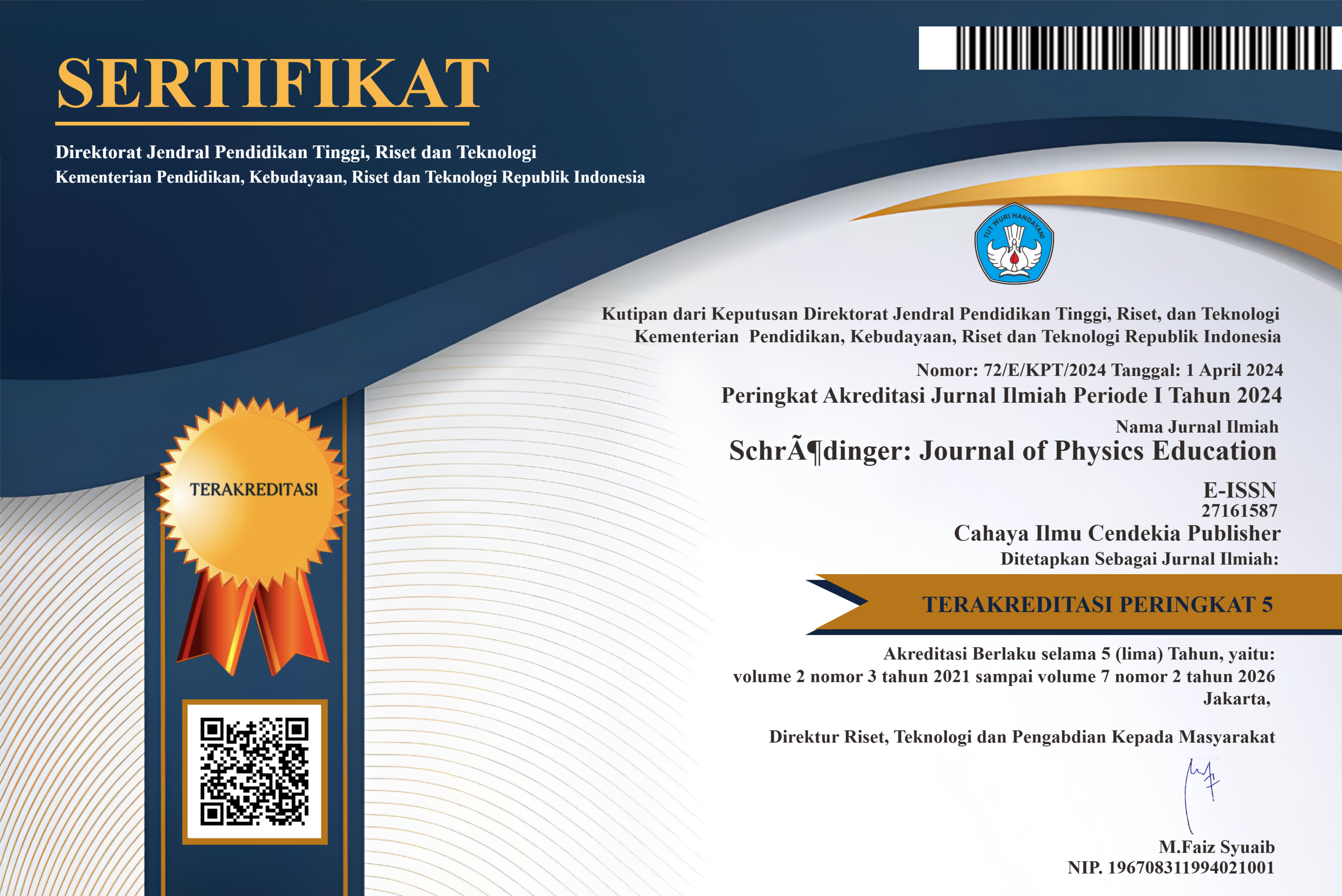Implementation of Learning with the Problem Posing Method to Increase Activeness and Learning Outcomes of Physics in the Material of Temperature and Heat
Abstract
Purpose of the study: This research aims to find out how physics learning using the Problem posing Method is implemented in high school and to find out whether learning physics using the Problem posing Method can increase the activeness and learning outcomes of high school students in physics.
Methodology: This type of research is classroom action research carried out in 2 cycles. This research was conducted in high school. The subjects of this research were 31 students of class X high school. The research data is in the form of student activity and learning outcomes. Students' learning activity is known from the results of observation sheets, while students' learning outcomes are known from the results of evaluations carried out at the end of each cycle.
Main Findings: The results showed that the active learning of students in cycle II showed an increase when compared to cycle I. The results showed learning with the Problem Posing model was preferred by students so that it was hoped that the teacher could apply the Problem Posing model as a variation in learning Physics. The limitation of the research which only applies the Problem Posing model to the material Temperature and Heat with a relatively short research time, it is hoped that further research can be carried out on other materials.
Novelty/Originality of this study: The novelty of this research is that classroom action research was carried out to determine students' activeness in the learning process using a problem posing model specifically for learning physics on temperature and heat.
References
K. Kamid, R. Rohati, H. Hobri, E. Triani, S. Rohana, and W. A. Pratama, “Process Skill and Student ’ s Interest for Mathematics Learning : Playing a Traditional Games,” Int. J. Instr., vol. 15, no. 3, pp. 967–988, 2022, doi: . https://doi.org/10.29333/iji.2022.15352a.
I. Susanti, “Analisis Sikap Dan Minat Siswa terhadap Pembelajaran Fisika di SMA,” SchrödingerJournal Phys. Educ., vol. 1, no. 4, pp. 117–120, 2020, doi: 10.37251/sjpe.v1i4.447.
D. Daud and Y. Triadi, “Implementasi Pendidikan Karakter Cinta Tanah Air dalam Proses Pembelajaran di Sekolah Dasar,” J. Basic Educ. Res., vol. 2, no. 1, pp. 15–19, 2021, doi: 10.37251/jber.v2i1.130.
S. H. Hamdo, “Hubungan Motivasi Belajar Dan Minat Belajar Terhadap Hasil Belajar Pendidikan Agama Islam Peserta Didik Kelas VIII SMP Negeri 26 Makassar,” J. Pendidik. Agama Islam Indones., vol. 3, no. 2, pp. 35–39, 2022, doi: 10.37251/jpaii.v3i2.626.
L. Hasibuan and A. Nugraha, “Development of Scientific and Constructivism-Based Handouts on Social Arithmetic Materials,” Indones. J. Educ. Res., vol. 4, no. 2, pp. 28–31, 2023, doi: 10.37251/ijoer.v4i2.578.
D. S. Juniwati, “Perbedaan Model Pembelajaran Dicovery Dan Model Pembelajaran POE (Predict-Observe-Explain) Pada Materi Perpajakan Di Kelas XI,” J. Soc. Knowl. Educ., vol. 1, no. 1, pp. 27–32, 2020, doi: 10.37251/jske.v1i1.47.
A. Setiawan, “Mengembangkan Nilai Karakter dan Kemampuan 4C Anak Melalui Pendidikan Seni Tari di Masa Revolusi Industri 4.0,” Didakt. J. Pendidik. dan Ilmu Pengetah., vol. 19, no. 2, pp. 193–211, 2019, doi: 10.30651/didaktis.v19i2.2958.
A. Ridlo, “Deskripsi Sikap Siswa dalam Mata Pelajaran IPA di SMP IT Ashidiqi,” J. Eval. Educ., vol. 1, no. 2, pp. 32–36, 2020, doi: 10.37251/jee.v1i2.42.
N. I. S. Pratiwi, “Deskripsi Keaktifan Belajar Siswa Terhadap Mata Pelajaran IPA di SMP Negeri 18 Kota Jambi,” Integr. Sci. Educ. J., vol. 1, no. 3, pp. 101–108, 2020, doi: 10.37251/isej.v1i3.77.
A. N. Fauziyah, M. Ramadan, P. R. Gumede, and I. N. Udosen, “Development of Physics Learning Media Using Kvisoft Flipbook : Bilingual Digital Books,” J. Educ. Technol. Learn. Creat., vol. 1, no. 1, pp. 7–15, 2023, doi: 10.37251/jetlc.v1i1.618.
Murniati and Erika, “Attitudes of Students : Adoption of Scientific Attitudes and Interest in Increasing Study,” SchrödingerJournal Phys. Educ., vol. 4, no. 1, pp. 7–11, 2023, doi: 10.37251/sjpe.v4i1.491.
M. Ubaidillah, “Pengembangan LKPD Fisika Berbasis Problem Solving untuk Meningkatkan Keterampilan Proses Sains dan Keterampilan Berpikir Tingkat Tinggi,” J. EduFisika, vol. 01, no. 02, pp. 9–20, 2016.
S. Saharuddin and M. Wahab, “Analisis Kesulitan Dalam Pemebelajaran Ipa Di Smp Negeri Limboro,” J. IPA Terpadu, vol. 2, no. 2, pp. 75–83, 2019, doi: 10.35580/ipaterpadu.v2i2.11148.
T. Putra, “Implementasi Model Pembelajaran Kooperatif Tipe Jigsaw dalam Meningkatkan Keaktifan Siswa Pada Mata Pelajaran Sosiologi,” J. Soc. Knowl. Educ., vol. 2, no. 3, pp. 56–59, 2021, doi: 10.37251/jske.v2i3.386.
E. R. Ramil, “Analisis Lingkungan Belajar Siswa Mata Pelajaran Fisika di Sekolah Menengah Atas Negeri 10 Kota Jambi,” Schrödinger J. Phys. Educ., vol. 1, no. 1, pp. 7–12, 2020.
A. Karacop, “The Effects of Using Jigsaw Method Based on Cooperative Learning Model in the Undergraduate Science Laboratory Practices,” Univers. J. Educ. Res., vol. 5, no. 3, pp. 420–434, 2017, doi: 10.13189/ujer.2017.050314.
A. Ekasari, “Application of E-Module to Identify Students ’ Science Process Skills in the Practicum of Refraction on Prisms,” SchrödingerJournal Phys. Educ., vol. 4, no. 2, pp. 30–35, 2023, doi: 10.37251/sjpe.v4i2.502.
Astalini, Darmaji, D. A. Kurniawan, S. W. Oktavia, E. Triani, and M. Z. Azzahra, “The Exploration of Character Values in Physics Learning on Momentum , Impulse , and Collision Materials,” J. Educ. Res. Eval., vol. 7, no. 2, pp. 277–284, 2023, doi: https://doi.org/10.23887/jere.v7i2.52381.
W. Arini and E. Lovisia, “Respon Siswa Terhadap Media Pembelajaran Alat Pirolisis Sampah Plastik Berbasis Lingkungan Di Smp Kabupaten Musi Rawas,” Thabiea J. Nat. Sci. Teach., vol. 2, no. 2, pp. 95–104, 2019, doi: 10.21043/thabiea.v2i2.5950.
S. W. Oktavia, H. Mansur, and M.Hidayat, “Investigasi Keterampilan Mengajar Guru Fisika di SMA N 9 Kerinci,” J. Relativ., vol. 6, no. 1, pp. 24–30, 2023.
D. A. Kurniawan, S. W. Oktavia, and F. P. Sinaga, “Identification of Student Character Values in Class X Particle Dynamics Materials,” vol. 8, no. 3, pp. 380–388, 2023.
M. C. Aktaş, “Problem-posing research in mathematics education : A bibliometric analysis,” J. Pedagog. Res., vol. 6, no. 4, pp. 217–233, 2022.
S. W. Octavia, N. Septiani, F. Sinaga, and N. N. Qoidah, “Analysis Of The Relationship In Learning Interest To Learning Outcomes Static Fluid Material In Senior High SchooL,” J. Ilm. Ilmu Terap. Univ. Jambi, vol. 87, no. 1,2, pp. 149–200, 2023, [Online]. Available: https://doi.org/10.22437/jiituj.v7i1.26696.
F. T. Aldila, E. F. S. Rini, Sri Wina Oktavia, N. N. Khaidah, F. P. Sinaga, and N. Septiani, “Edufisika : Jurnal Pendidikan Fisika Volume 8 Number 1 , April 2023,” Edufisika J. Pendidik. Fis., vol. 8, no. 1, pp. 101–105, 2023, doi: 10.59052/edufisika.v8i1.24864.
R. Farida, A. Alba, R. Kurniawan, and Z. Zainuddin, “Pengembangan Model Pembelajaran Flipped Classroom Dengan Taksonomi Bloom Pada Mata Kuliah Sistem Politik Indonesia,” Kwangsan J. Teknol. Pendidik., vol. 7, no. 2, p. 104, 2019, doi: 10.31800/jtp.kw.v7n2.p104--122.
A. Abbas and M. Yusuf Hidayat, “Faktor-Faktor Kesulitan Belajar Fisika Pada Peserta Didik Kelas IPA Sekolah Menengah Atas,” JPF (Jurnal Pendidik. Fis. Univ. Islam Negeri Alauddin Makassar, 2018, doi: 10.24252/jpf.v6i1a8.
J. P. Casquilho, F. Sinaga, N. Septiani, S. W. Oktavia, N. N. Qoidah, and E. F. S. Rini, “The Influence of Critical Thinking Ability on Students’s Science Learning Outcomes,” EduFisika J. Pendidik. Fis., vol. 8, no. 2, 2023.
A. Suyitno, Pembelajaran Inovatif. Semarang: Jurusan Matematika FPMIPA Universitas Negeri Semarang, 2009.
H. Polat and M. Özkaya, “The effect of problem posing-based active learning activities on problem-solving and posing performance : The case of fractions,” J. Pedagog. Res., vol. 7, no. 1, pp. 67–81, 2023.
R. Alamsyah, “Penerapan Pendekatan Problem Posing Berbasis Aktivitas Dalam Pembelajaran Fisika Di Man 4 Sukabumi,” MADRASCIENCE J. Pendidik. Islam. Sains, Sos. dan Budaya, vol. 3, no. 1, pp. 29–38, 2021.
S. Hafizah, S. Miriam, and M. Misbah, “Meningkatkan Keterampilan Proses Sains Peserta Didik Pada Materi Elastisitas dan Hukum Hooke Berorientasi Learner Autonomy,” J. Ilm. Pendidik. Fis., vol. 4, no. 2, p. 76, 2020, doi: 10.20527/jipf.v4i2.2060.
D. R. Amelia, M. S. Sumantri, and E. Utomo, “Establishing Character Education in Elementary School: Increasing Concern and Environmental Responsibility Through Habiting and Modeling Working Group Activities,” Int. J. Multidiscip. Curr. Res., vol. 6, no. 04, pp. 779–785, 2018, doi: 10.14741/ijmcr/v.6.4.15.
Sudjana, Metoda Statistika. Bandung: Tarsito, 2005.
J. E. Calabrese, M. M. Capraro, and C. G. Thompson, “The Relationship Between Problem Posing and Problem Solving : A Systematic Review,” Int. Educ. Stud., vol. 15, no. 4, pp. 1–8, 2022, doi: 10.5539/ies.v15n4p1.
Copyright (c) 2023 M. Purnomo, Wan Mohm Aimran, Singha Prasitpong

This work is licensed under a Creative Commons Attribution-NonCommercial 4.0 International License.
Authors who publish with this journal agree to the following terms:
- Authors retain copyright and acknowledge that the Schrödinger: Journal of Physics Education is the first publisher licensed under a Creative Commons Attribution 4.0 International License.
- Authors are able to enter into separate, additional contractual arrangements for the non-exclusive distribution of the journal's published version of the work (e.g., post it to an institutional repository or publish it in a book), with an acknowledgment of its initial publication in this journal.
- Authors are permitted and encouraged to post their work online (e.g., in institutional repositories or on their website) prior to and during the submission process, as it can lead to productive exchanges and earlier and greater citation of published work.






.png)
.png)








.png)
.png)
.png)







